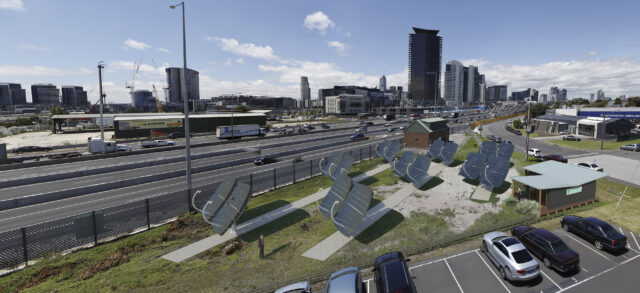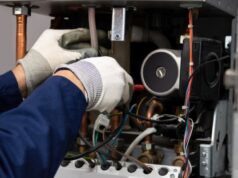
An Australian renewable energy company is set to show off its Combined Heat and Power (CHP) solar technology at a demonstration site in Melbourne.
In conventional power generation, large quantities of energy (in the form of heat) often end up going to waste. And as the discussion of energy efficient technologies becomes increasingly common among electricians, government organisations and home owners, it’s important to be aware of some of the alternatives on offer.
Combined Heat and Power (CHP) solar technology involves the simultaneous production of electricity and heat through the use of photovoltaic (PV) panels. In this case, a small solar array can not only produce energy from the panels, but also thermal energy which can be used to supply hot water.
Also referred to as cogeneration, CHP solar technology is not a standalone process but rather an integrated energy system that can be modified depending on the needs of the end user. Using this technique, total energy conversion efficiency can reach up to 75%.
Given that electricians already have links to residential PV systems, CHP technology could also prove to be a useful alternative for those wishing to heat water in a more energy-efficient manner.
To demonstrate how the technology works, renewable energy company Greenearth Energy has teamed up with Israel-based ZenithSolar to introduce a High Concentration Photovoltaic (HCPV)/HCP solar technology called the ZenithSolar Z20. With applications already in Israel, Korea and China, there are plans to create a demonstration site of the technology in Port Melbourne, near Melbourne’s CBD.
“The proposed demonstration site, with its unique central location, will allow potential investors, project developers and off-take customers easy access to the technology,” Greenearth Energy managing director Mark Miller says.
“Eight Z20 units on the proposed site would produce a peak output of 88kW of thermal energy (hot water) and 36kW of electrical energy.”
So how does the technology work? A ZenithSolar Z20 optical dish uses multiple flat mirrors mounted on a plastic surface. This is divided into four quadrants and fixed onto a metal frame to form a dual axis solar tracking system.
A single unit features two 11m² collectors that concentrate incoming solar power onto a receiver. The Z20 receiver converts the solar power into DC electrical power and thermal energy. The DC power is then converted to AC power and fed directly to a customer or the grid while thermal energy, in the form of heated water, is pumped through a closed loop system to customer applications.
This solves a common problem found in conventional CPV systems, where the excess heat generated in the solar cell is usually removed and wasted to avoid damaging the cell and to maintain the high efficiency of electricity conversion.
“The ZenithSolar Z20 system utilises the heat generated at the solar cell receiver to provide usable hot water, improving overall solar conversion efficiency. The ZenithSolar Z20 system delivers dual heat and power outputs from a single, small footprint unit,” Mark says.
“Each individual Z20 system can produce a peak output of 4.5kW of electricity and 11kW of hot water. As with all things solar-related, how much it produces over a day and a year depends on the location.
“The proposed site is currently a vacant block of land and the demonstration site will ‘run’ for at least 12 months after commissioning.”
While the demonstration system is currently targeted at commercial-scale applications, Mark says that electricians can use the technology as an opportunity to separate themselves from the competition.
“We are aiming to package up the plant so that the installation tasks for plumbers are similar to installing a standard solar hot water system, and the installation tasks for electricians are similar to installing a standard roof-mounted solar PV system. Having said that, a combined heat and power dish installation is larger than a residential system,” he says.
“One other important difference is that there are other parties that need to be involved such as civil contractors for foundations and authorities for planning approvals. The installation process involves the construction of the dish array, plumbing in the hot water as a solar pre-heater to an existing gas or electric hot water service, and then to connect the electrical output to the customer-side of the electricity meter. Once this is done, a control system is installed to manage the way the dishes track the sun’s path throughout the year.”
Greenearth Solar Energy (a subsidiary of the company) is also assessing further electricity and hot water off-take options, including the potential to supply hot water to the nearby Ambulance Victoria Port Melbourne branch. Located directly opposite the proposed demonstration site the branch has, according to an initial assessment, similar hot water (thermal heat) requirements to the output of the proposed eight unit Z20 CHP configuration.
Mark says the ability to export emissions-free electricity to the grid while assisting Ambulance Victoria with its hot water usage would showcase the ZenithSolar Z20 technology’s combined heat and power capabilities to its full potential. The technology could also extend to other ‘niche applications’ including hospitals and aged care facilities; hotels, resorts and leisure centres; municipal offices and swimming pools; or universities and technology/industrial parks.
“By the very nature of the technology, the dual outputs – electrical (electricity) and thermal (hot water) – deliver up to 75% efficiency, one of the most efficient solar energy systems available in the world today,” he explains.
“We believe the ZenithSolar Z20 has the potential to efficiently deliver the dual benefits of emissions-free power and hot water to a wide range of customers. We look forward to successfully delivering the Victorian trial and moving to full distribution within Australia and the wider Pacific region.”





